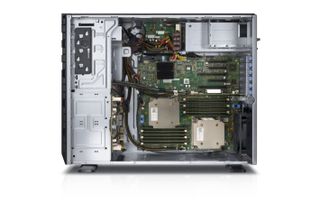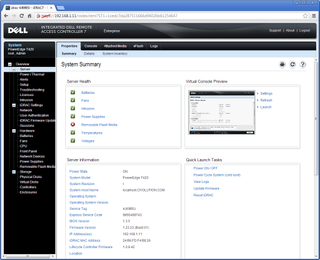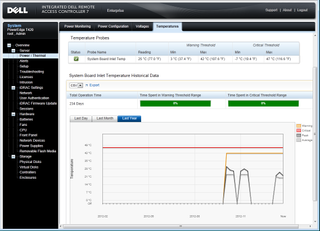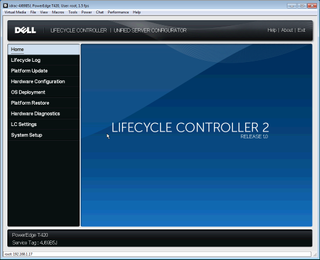IT Pro Verdict
The PowerEdge T420 delivers a fine combination of built quality, design and low noise levels. Despite its size, it’s a very versatile pedestal server with a high storage potential and has enough E5-2400 Xeon power on tap to handle most SMB workloads.
Pros
- +
Compact and well built chassis; Quiet; Excellent storage potential; Good virtualisation features
Cons
- -
Expensive for SMBs that don’t need dual E5 Xeons
Dell's PowerEdge T420 is the latest to join burgeoning range of pedestal servers and offers growing SMBs an affordable, expandable and versatile 2P platform.
The T420 is capable of handling a wide range of duties including Exchange, database, messaging and file sharing services. It also has the horsepower to consolidate older servers onto a single platform and has a few tricks up its sleeve for virtualisation.
It's powered by dual E5-2400 Xeons which Intel offers as a lower cost alternative to its E5-2600s. The E5-2400 CPUs aren't actually much cheaper but the motherboards cost less to manufacture as their Socket-B2 (LGA1356) package has one inter-socket QPI link and support for 12 DIMM slots as opposed to 24.
The price for the review system includes a pair of 2.2GHz E5-2430 Xeons. These are members of Intel's Standard E5-2400 family and have six cores, a 15MB L3 cache, a 7.2GT/sec QPI and support for 1,333MHz memory speeds.

The well designed and spacious interior makes the PowerEdge T420 very easy to upgrade
Storage options
To keep costs down you can order the base system with four cold-swap drive bays where the backplane is cabled directly to the motherboard's 3Gbits/sec SATA port. Consider your future expansion demands carefully, though, as if you choose this option you can't upgrade to a larger hot-swap cage later on.
The review system was supplied with an 8-bay SAS/SATA hot-swap drive cage and to enable all eight bays you must use one of Dell's PERC PCI-e RAID cards. A good choice is on offer and includes the PERC H710 PCI-e card with 512MB of cache which supports RAID-6.
Businesses with a real hunger for storage can also order the T420 with a 16-bay SFF hot-swap cage. It supports SAS or SATA drives and, along with the 8-bay model, you can choose from pedestal or rack mount chassis configurations as well.

Dell's iDRAC7 Enterprise upgrade adds remote control and virtual media support
Dell's Fresh Air initiative
The T420 is a good choice for small offices as it's compact enough to sit on a desk and extremely quiet. A single 12cms diameter fan at the back deals with all chassis cooling and we had to turn everything else off in the lab before we could hear it.
Even if things get a little toasty in the office you're covered by Dell's Fresh Air initiative. The T420 is certified to run safely at 40C for 900 hours in a year including up to 45C for 90 hours in the same period although it should be noted this is only supported on systems that have dual redundant PSUs.
How will you know if these thresholds are being reached? Check out the temperature monitoring page in Dell's iDRAC7 remote console as this has bar graphs showing time spent in the warning and critical thresholds.

Dell's Fresh Air thresholds are monitored from the iDRAC7 controller
Remote management and virtualisation
Dell has simplified iDRAC7 upgrades as the system starts with the Express model but has all the hardware in place for the Enterprise upgrade as included in the review system. Add a license key and it'll activate the dedicated management port and vFlash slot along with remote control and virtual media services.
The T420 is a good fit for virtualisation as Dell is still the only one offering hypervisor redundancy. Its dual SD card controller snaps into a slot at the top of the motherboard and mirrors the primary boot SD media in case it fails.
The review system includes dual 750W load balanced power supplies but for lighter duties you can specify a 495W module. For applications such as desktop virtualisation and medical imaging you can fit dual nVidia GPU cards but you'll want to step up to 1100W power supplies.
The E5-2430 Xeons have a 95W TDP and our power tests measured a modest 87W draw with Windows Server 2012 in idle. With the SiSoft Sandra benchmarking app maxing out all 24 logical cores, this peaked at only 230W.

Dell's latest Lifecycle Controller provides new features such as hardware inventory and configuration backups
The new Lifecycle Controller
Dell's LifeCycle Controller makes OS installation a breeze and the latest v2 adds even more features. You can directly access the LifeCycle log to view, export and annotate it, gather hardware inventory at every reboot and backup the server's hardware configuration as profiles.
Agentless monitoring means you can keep a check on the server irrespective of whether the OS is running. From the iDRAC7 console you can also ask for email alerts to be issued when faults are detected and these contain a link to the web console.
Conclusion
The T420 has little competition from the other blue chips as IBM doesn't have an E5-2400 pedestal server and Fujitsu's Primergy TX150 S8 is a single socket system. Only HP's ProLiant ML350e Gen8 stands in Dell's way but some SMBs will find this 74cms deep server far too large for their requirements.
Along with a solid built quality, the PowerEdge T420 packs a lot of hardware into its compact dimensions. Its low noise levels make it a good choice as a central server for small or branch offices and the dual Xeon E5 CPUs have enough power to handle just about any task you can throw at it.
Verdict
The PowerEdge T420 delivers a fine combination of built quality, design and low noise levels. Despite its size, it’s a very versatile pedestal server with a high storage potential and has enough E5-2400 Xeon power on tap to handle most SMB workloads.
Chassis: Pedestal with 8 drive bays (16 optional)
CPU: 2 x 2.2GHz Xeon E5-2430
Memory: 48GB DDR3 RDIMM (max. 384GB)
Storage: 2 x 500GB SATA and 3 x 300GB SAS hot-swap hard disks
RAID: Dell PERC H710 with 512MB DDR3 cache
Array support: RAID0, 1, 10, 5, 50, 6, 60
Network: 2 x Gigabit
Expansion slots: 6 x PCI-e 3.0
Power: 2 x 750W hot-plug PSUs
Management: Dell iDRAC7 Enterprise
Warranty: 3yrs on site NBD after remote diagnostics
Dave is an IT consultant and freelance journalist specialising in hands-on reviews of computer networking products covering all market sectors from small businesses to enterprises. Founder of Binary Testing Ltd – the UK’s premier independent network testing laboratory - Dave has over 45 years of experience in the IT industry.
Dave has produced many thousands of in-depth business networking product reviews from his lab which have been reproduced globally. Writing for ITPro and its sister title, PC Pro, he covers all areas of business IT infrastructure, including servers, storage, network security, data protection, cloud, infrastructure and services.



